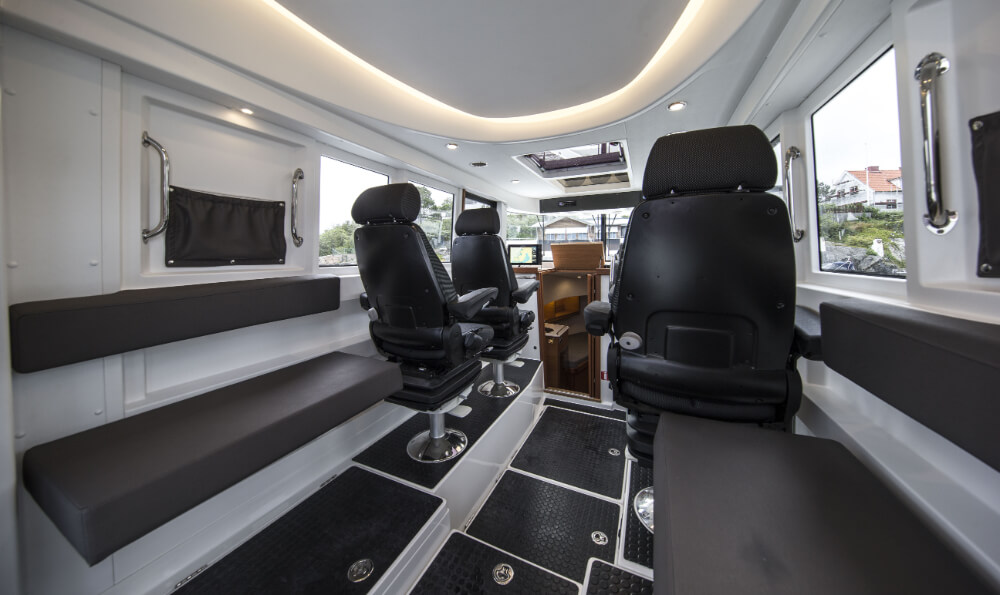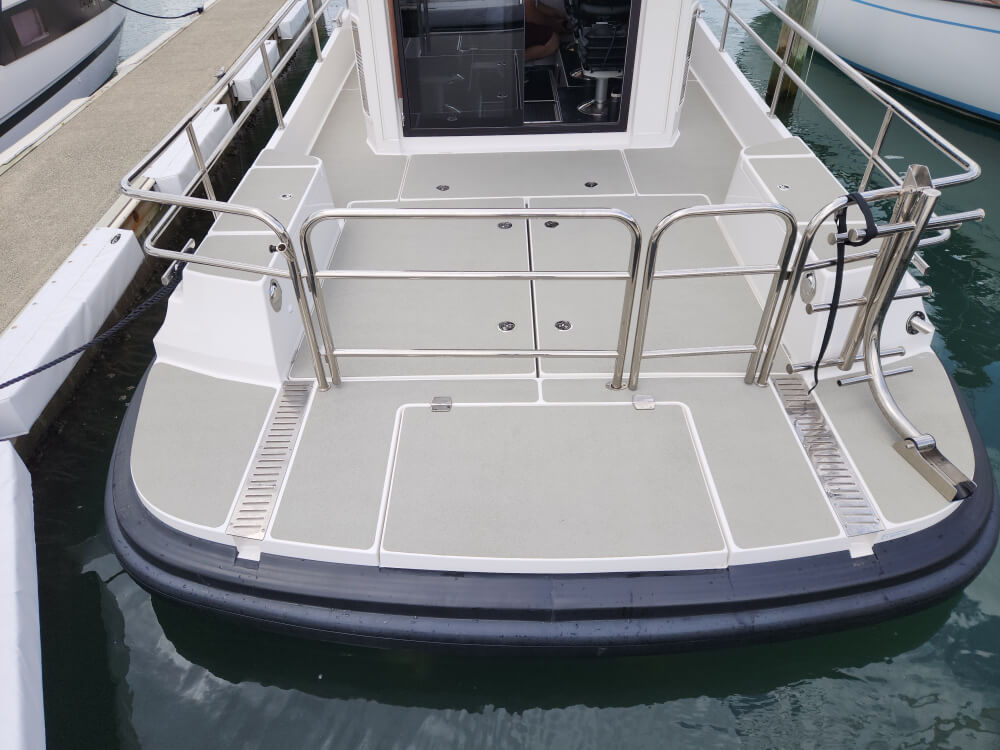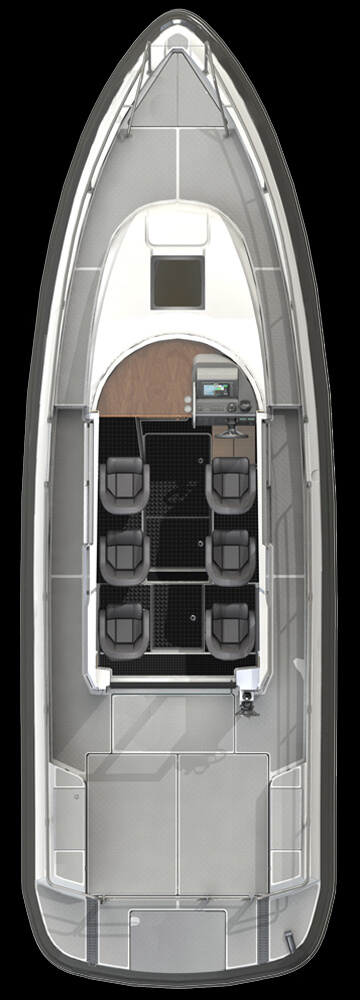365 DAY BOATING
Test by Barry Thompson
The Paragon 31 is as tough as it looks and has the seakeeping abilities to match. It’s a walk-around wheelhouse boat with attitude.
Paragon isn’t a brand that is that familiar in Zealand. To date, there has only been one imported by Kiwi dealer, Sports Marine, a Paragon 25. A bit of background to the brand. They are built in Sweden and are part of the well-known Nimbus Boat Group.
The Paragon range, consisting of four models from 8.52m to 10.59m, comes with a distinctive Scandinavian look. In 2021 I reviewed the smaller Paragon 25, and I still remember how impressed I was with how the boat handled. They may look more commercial than recreational, but once you get aboard, you realise that Paragon has serious eyes on the leisure market.
The Paragon 31 has four different layouts to suit leisure and commercial buyers. The more commercial version is designed for use by harbour authorities, police, customs, coastguard or where ever a rugged, seaworthy boat is required. It is also available with an open flybridge.
COMMUTER BOAT
When the owner of this particular Paragon 31 approached Sports Marine, he required a serious commuter boat for the Hauraki Gulf. Hence the very clinical layout of the saloon is a little overwhelming with six huge chairs.

They are not just ordinary seats. They are electric Grammer air suspension seats and are the same as you would find in the commercial version of the Paragon 31. If this is too much, a four-seat version is available, leaving the rear space in the wheelhouse for a small galley or extra seating. The seats are mounted on raised platforms with a lower centre section providing a deep walkway over 2.2m headroom. Paragon offer a more conventional bucket seat style if you don’t want to go to the more commercial Grammer seats.
With the owner of this boat using it primarily as a transport vehicle, little consideration was given to the rest of the layout. However, even in this mode, it has enough creature comforts to be a usable dayboat.
The six or four-seater versions will not be for everyone, so Paragon have a far more conservative and somewhat traditional layout that will relate to Kiwis.

The saloon sees a couple of bucket seats forward, with an extra seat and galley unit to starboard, with the L shape settee to port. This provides a more relaxing atmosphere and transforms the harsh commuter aspect into a comfortable and roomy pleasure mode. There are three extra large storage lockers in the wheelhouse sole, with one providing easy access to the fuel tank should you need to do maintenance. You have the choice of a rubber surface or teak and holly which gives the interior a more recreational and friendly feel.
What remains the same in all models is the starboard side helm, the pair of sliding doors to the bulwarks and a sizeable rear sliding door. The side doors are a great feature, giving you instant access to the side decks should you go forward for an anchoring issue or when laying up in a berth or jetty.

The heavy-duty stainless railing also has a gate on either side. The helm on our boat was fitted with a single Simrad 16″ MFD, flanked by Volvo Penta gauges, Humphree controls, and a Mastervolt battery monitor. There is plenty of space to fit all your electronics and controls with everything at a nice eye and hand level.
Being a boat built primarily for boating in extreme Scandanavian weather conditions, the Paragon 31 comes with a diesel heater. Another plus for making this a 365 year around boat.
OPEN COCKPIT
The Paragon 31 has an open cockpit with no moulded transom, so you need to ensure that before your head out of the marina, all the shoes and gear are off the cockpit floor. There are lockers on either side for storage, with a forward technical locker in the cockpit sole, which doubles as another storage space.

Access to the pair of Volvo Penta D4 320s is by large floor hatches. If you want to stow wet dive gear or your day’s catch, the Paragon 31 comes with a wet locker on the boarding platform.
On the starboard side of the boarding platform, is a extra large drop down stainless step ladder which is a plus for divers. Removable rails divide the cockpit from the bparding platform. However, it would be no trouble to retrofit a full wrap around stainless rail with a gate around the boarding platform and eliminate the one at the rear of the cockpit. It would make this area much more practical and user-friendly. This would allow you to add a bait station and also still allow you to fit some dinghy davits.
PERFORMANCE
I could go on and on about the seakeeping and how the boat tackles the rougher sea, but when you know that the hull is based on an ultra-deep vee with 24.5 deg at the transom, you can understand why.

The beam is 3.38m, with broad flat chines and three deep spray rails aside doing a lot of the work. A solid rubber belting around the hull also helps deflect the spray and doubles as your in-built fender.
There is also a set of Humphree interceptors to help assist the ride and attitude of the boat. Now I can hear you say, but what about the stability at rest? Well, it’s not much different to any other boat this size. Due to the deep vee of the hull, you can’t get away from the boat leaning in the turns a little more than you might expect from a boat with a flatter transom area, but with the Humphrees interceptors set on auto, that can be largely reduced. However, if you need more convincing about the at-rest stability, you can always add a gyro.

While driving the boat, there is excellent visibility from the helm with a split curved vertical window, complete with four wipers. The helm seat is fully adjustable, and you feel the air suspension seats’ benefits when running in rough water.
Power options offered are a single Volvo Penta D6-400 or D6-440, or if you want more speed, you can upgrade to twin D4-300 or D4-320 Aquamatics. That is a considerable variation of power, so the choice of engines will be down to cost and your performance expectations. With a pair of D4 320s, I recorded 40.3 knots @ 3700 rpm. Maximum fuel burn was 142 lph, but that dropped right back to 84 lph at 3000 rpm and 28.2 knots. If you are happy to cruise around 20 knots then the fuel burn is going to be loser 50 lph for both engines. Reasonably economical boating I would suggest.

Despite the hull’s extra deep vee, it leaps onto the plane with ease and rapidly achieves maximum velocity. It’s a hull that is affected a lot by trim so it took a little to get it right. Once I did it ran well in all directions, especially in the following sea when I trimmed the legs well out and ran a constant 40 knows coming back into Auckland’s inner harbour.
ACCOMMODATION
The Paragon 31 is a single-cabin three berth boat. The main cabin area features twin 2m berths that can be transformed into a single two sqm berth with the aid of an infill. Storage is plentiful under the berths and inside lockers. Light and ventilation comes via a single hull port, concealed and flush lighting, plus a large overhead hatch.
The third berth slips in under the port side of the wheelhouse sole and, when not used for accommodation, is a great storage space.
The rest of the space downstairs is taken up with a vanity with storage under or a compact galley to port and bathroom opposite. The optional galley comes with all you need to prepare small meals with a sink unit, a three-burner cooktop neatly concealed under a foldaway bench top, and draw storage and a fridge below.
The generous size of the bathroom surprised me. You can stand up to shower with a flexible shower rose. There is the usual head, a good size vanity and lockers that offer some dry storage for the towels and the toilet roll. All the shower water drains passed a teak-slated floor panel into a holding tank.



CONCLUSION
The forward-thinking Scandinavian design and attention to detail are not lost on this brand. With clean lines, multiple deck layouts and built with hardwearing materials, the Paragon 31 is purpose-built tough and ready for whatever you throw at it. The availability of different interior layouts makes it even more appealing. It combines clean modern lines, a sporty performance, and excellent seaworthiness. Although a relatively unknown boat brand in this corner of the world, I see the Paragon fitting perfectly into New Zealand’s harsh and volatile environments. It’s different, but then why not. Being non-conformist regarding the designs produced by local builders, the Paragon offers a refreshing approach to how and in what we go boating. Certainly a boat that offer 365 days a year boating capability.
SPEC SHEETS
- Model: Paragon 31 Cabin
- Priced from: $NZ825,000
- LOA: 10.59m
- Beam: 3.38m
- Draft: 1.18m
- Deadrise: 24.5 deg
- Displacement: 5600kg
- Fuel capacity: 700 litres
- Water capacity: 200 litres
- Black water: 70 litres
- CE–category: B
- Hatches: Lewmar
- Interceptors: Humphree
- Lighting: Hella
- Invertor: Mastervolt
- MFD: Simrad 16”
- Radar: Simrad Halo
- Winch: Lewmar
- Diesel Heater: Eberspacher
- Power: 2 x Volvo Penta D4-320 Aquamatic DPI
- Contact: www.sportsmarine.co.nz
FUEL & PERFORMANCE | ||||
| RPM | KNOTS LPH NMPL | RANGE | ||
| 1500 | 5.6 | 20 | 3.6 | 176 |
| 2000 | 11 | 44 | 4 | 158 |
| 2500 | 19.5 | 53 | 2.7 | 230 |
| 3000 | 28.2 | 84 | 3 | 212 |
| 3500 | 36.3 | 127 | 3.5 | 180 |
| 3700 | 40.6 | 142 | 3.5 | 180 |
| Range is based on 10% reserve of full tanks. | ||||




